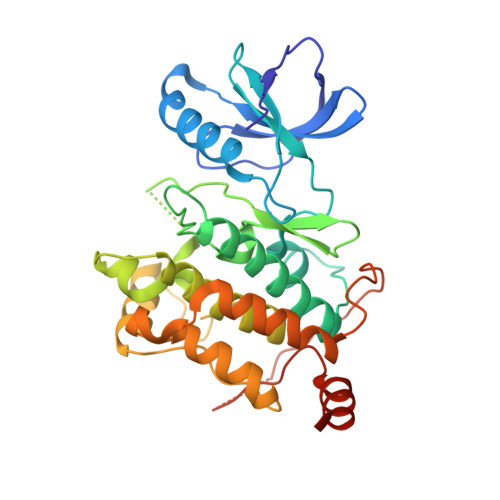Development of a Method for Converting a TAK1 Type I Inhibitor into a Type II or c-Helix-Out Inhibitor by Structure-Based Drug Design (SBDD)
Muraoka, T., Ide, M., Irie, M., Morikami, K., Miura, T., Nishihara, M., Kashiwagi, H.(2016) Chem Pharm Bull (Tokyo) 64: 1622-1629
- PubMed: 27803473
- DOI: https://doi.org/10.1248/cpb.c16-00606
- Primary Citation of Related Structures:
5GJD, 5GJF, 5GJG - PubMed Abstract:
We have developed a method for converting a transforming growth factor-β-activated kinase 1 (TAK1) type I inhibitor into a type II or c-helix-out inhibitor by structure-based drug design (SBDD) to achieve an effective strategy for developing these different types of kinase inhibitor in parallel. TAK1 plays a key role in inflammatory and immune signaling, and is therefore considered to be an attractive molecular target for the treatment of human diseases (inflammatory disease, cancer, etc.). We have already reported novel type I TAK1 inhibitor, so we utilized its X-ray information to design a new chemical class type II and c-helix-out inhibitors. To develop the type II inhibitor, we superimposed the X-ray structure of our reported type I inhibitor onto a type II compound that inhibits multiple kinases, and used SBDD to design a new type II inhibitor. For the TAK1 c-helix-out inhibitor, we utilized the X-ray structure of a b-Raf c-helix-out inhibitor to design compounds, because TAK1 is located close to b-Raf in the Sugen kinase tree, so we considered that TAK1 would, similarly to b-Raf, form a c-helix-out conformation. The X-ray crystal structure of the inhibitors in complex with TAK1 confirmed the binding modes of the compounds we designed. This report is notable for being the first discovery of a c-helix-out inhibitor against TAK1.
Organizational Affiliation:
Research Division, Chugai Pharmaceutical Co., Ltd.















